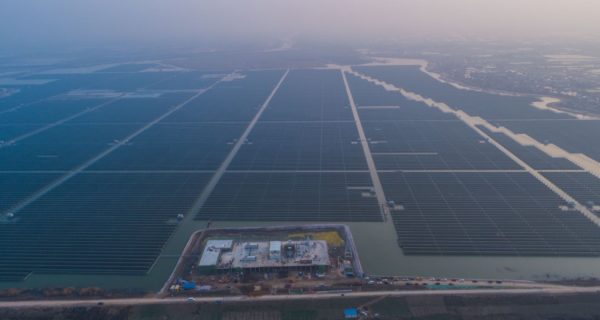China General Nuclear Power Group (CGN) has commissioned a 260 MW PV plant at a fishery in Dangtu county, in the Chinese province of Anhui.
According to CGN, the plant was built by its CGN New Energy Holdings unit and is selling power through a private PPA at a price of $0.054 per kWh. The project covers a water surface of more than 400 hectares. According to its owner, construction began in mid-September and took only 98 days to complete.
This week, Huawei revealed more details about the largest unsubsidized solar plant ever built in China to date. The company provided its string inverters for the facility. It said that the project was the first such installation to be approved by the National Development and Reform Commission (NDRC) in 2019.
The plant uses an overhead large platform on which all equipment foundations are set and was deployed with 88,866 pipe piles. The developers had to face several challenges, including high requirements for fishery-solar integration and the need for piling and routing cables for water-based operations. Huawei added thatO&M activities at the site will be particularly expensive and time-consuming, while noting how it also presents risks for a drop in module performance stemming from potential induced degradation (PID).
Huawei’s proprietary technology to build a virtual neutral point through solar inverter circuits was used to mitigate the risk of PID effects. “Compared with traditional solutions that use resistors or inductors to build the neutral point, Huawei’s PID suppression technology represents a major upgrade as it reduces compensation losses and ensures safety throughout the process,” the company stated. “As a result, energy yield increases by more than 2% while supporting a larger array of more than 5 MW.”
The plant was built with Huawei SUN2000 inverters, configuring each megawatt with 80 maximum power point trackers (MPPTs). “This minimizes the impact of PV module mismatch caused by shading, inappropriate direction, and other factors, and improves the system efficiency, ensuring high energy yields,” the manufacturer said.
The water-based solar plant also relies on a communication solution provided by Huawei itself: the MBUS broadband power line communication technology. According to the company, it enables the transmission of signals from the module arrays over the power lines with a transmission rate of 115 kbit/s.
China outlined its plan to spur the development of subsidy-free projects at the beginning of last year. In May, the Chinese government introduced its Mandatory Renewable Energy Consumption Mechanism, which from this year is imposing a mandatory requirement for the purchase of renewable energy on state, provincial and private grid operators, as well as electricity retailers, industrial entities with their own power generation facilities, and large electricity consumers involved in bilateral energy trading.






